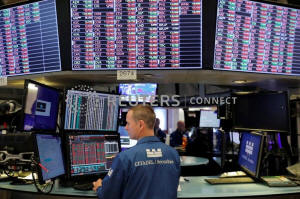Wall St. week ahead: Another recent inversion could provide support for
stocks
 Send a link to a friend
Send a link to a friend
 [September 07, 2019]
By Chuck Mikolajczak [September 07, 2019]
By Chuck Mikolajczak
NEW YORK (Reuters) - A decline in interest
rates on long-term U.S. government bonds below the average stock
dividend yield has received less attention than an inverted Treasury
yield curve, but it could be a reason stocks find support after a
bruising August.
After the S&P 500 <.SPX> suffered its first monthly drop since May, in
part because the Treasury curve inversion is seen by many as a harbinger
of recession, equities have gotten off to a solid start in September,
historically their worst month of the year. The uncommon Treasury
bond/dividend yield inversion is providing a level of support.
U.S. Treasury yields have fallen in step with a global bond market rally
as the trade war between China and the United States has kept recession
fears on the horizon. Negative yields on government debt in countries
such as Germany and Japan have also helped to depress those on U.S.
Treasuries.
While yields on intermediate-term Treasuries have been below the S&P
500's dividend yield for several months, the long-term 30-year yield
<US30YT=RR> inverted at the end of August, the first time since March
2009, when stocks bottomed to mark the start of the current bull run.

"Whether it is the Federal Reserve signaling more cuts in the future or
just in general this rally in the bond market, overall lower rates - you
would think - put some sort of floor on the market as well," said Mark
Kepner, equity trader at Themis Trading in Chatham, New Jersey.
"It's pretty clear that the $17 trillion in negative-yielding bonds have
been a black hole that sucks yields lower and lower in the U.S.," said
Don Ellenberger, head of multi-sector strategies at Federated Investors
in Pittsburgh.
With the dividend yield for the S&P 500 now above that of the 30-year,
investors may look to stocks with high dividends for income.
After dropping 1.8% in August, the S&P has gotten off to a fast start in
September to completely erase that decline, in part due to gains in
sectors such as energy <.SPNY> and consumer discretionary <.SPLRCD> that
contain stocks with high dividend yields.
"There’s a complete disconnect between the stock and bond markets," said
Terri Spath, chief investment officer at Sierra Mutual Funds in Los
Angeles.
"Some people are buying stocks for their dividends and bonds for capital
appreciation."
With each of the three major Wall Street indexes coming off monthly
declines in August, investors may be tempted to look elsewhere in the
short-term as September has been the worst- performing month for each
since 1950, according to the Stock Trader's Almanac. The S&P has
averaged a monthly decline of 0.5% and the Dow Industrials <.DJI> a 0.7%
fall in the last month of the third quarter over that time.
[to top of second column]
|

A trader works on the trading floor at the New York Stock Exchange
(NYSE) in New York City, U.S., September 3, 2019. REUTERS/Andrew
Kelly/File Photo

But the higher dividend yields compared with government bonds could
provide some incentive for stocks. Data from Sam Stovall, chief
investment strategist at CFRA Research in New York, shows that there
have been 31 instances since World War II when the S&P dividend
yield exceeded that of the 10-year note. The benchmark index was
higher a year later by an average of 22%, gaining in price 74% of
the time.
Over the same time period, Stovall found 20 occurrences of the yield
on the S&P topping that of the 30-year Treasury. In the following
year, the index had risen by an average of 12% while climbing 80% of
the time.
"At some point an absolute thing kicks in and you go 'Well, where am
I going to get my income from?' and the income- producing stocks,
the yielding stocks are an attractive place to go," said Thomas
Martin, senior portfolio manager at Globalt Investments in Atlanta,
Georgia.
Of S&P 500 components, 310 held a dividend yield above that of the
10-year note <US10YT=RR>, while 333 stocks' yields were above the
5-year <US5YT=RR> and 253 had yields higher than that of the 30-year
bond through Wednesday's close.
Recent inversions along the yield curve have triggered worries about
an economic slowdown, as they have preceded each recession since
1970.
Should a recession take place, stocks will decline and companies
could also begin to cut dividends in an effort to conserve cash,
further denting their attractiveness to investors.
"If in fact Treasury yields are forecasting a recession, then you’d
prefer to own Treasuries at lower yields because equities are likely
to sell off," said Erik Knutzen, CIO of Multi Asset Class at
Neuberger Berman in New York.
However, a recent note from Bank of America-Merrill Lynch Global
Research's Savita Subramanian recommended investors stick with
stocks over bonds over both the short and long-term, in part due to
their dividend yield and relative cheapness over bonds, while also
noting fewer than half of their bear market signals have been
triggered.

"For long-term investors, valuations suggest 6% annual returns; add
2% for dividends and this beats most fixed income offerings," said
Subramanian.
(Additional reporting by Richard Leong; Editing by Alden Bentley and
Dan Grebler)
[© 2019 Thomson Reuters. All rights
reserved.]
Copyright 2019 Reuters. All rights reserved. This material may not be published,
broadcast, rewritten or redistributed.
Thompson Reuters is solely responsible for this content. |